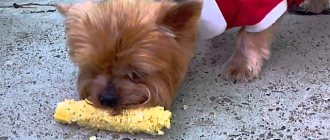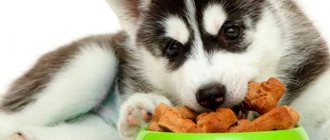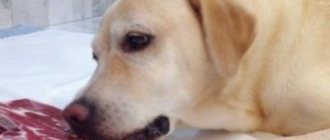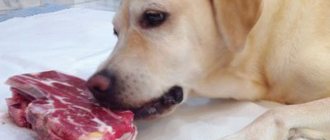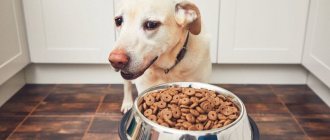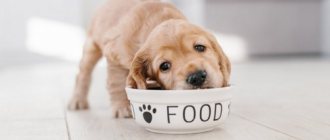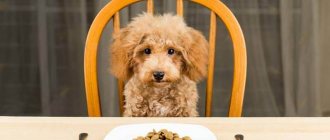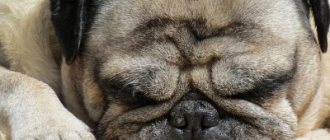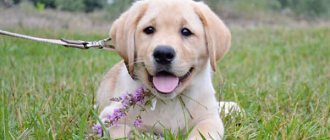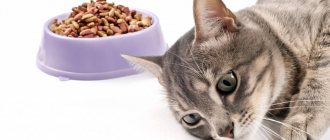The type of dog called retrievers includes six breeds . Among them there are very popular breeds - golden retriever and labrador .
These animals are born hunters . They have an excellent sense of smell, a soft jaw and an easy-going nature. When hunting, they work in tandem with a cop: while the first detects the game, the second brings the shot prey to the owner without biting it.
In modern urban conditions, Labradors are kept at home not as hunter's assistants, but as pets. These are very kind dogs that love to play with children and can be just a good friend to anyone.
A feature of the breed is its tendency to gluttony - they are ready to eat any amount of food. This dog breed is also prone to obesity. Therefore, Labradors need long walks (in parks, squares, in the forest) and active games.
One of the most important elements of keeping any pet, especially such a large one, is nutrition .
To the question, what is the best food to feed a Labrador? The answer is clear - meat is the basis of any dog’s diet.
Important! Your Labrador needs to be fed regularly and at the same time. This will ensure balanced development along with the immediate composition of food.
Ready-made food for Labrador puppies
The diet of many young Labrador retrievers consists of commercial dry and wet food. And the choice of their owners is justified: such products are balanced, healthy, nothing needs to be prepared, dry industrial food does not spoil for a long time, and wet food is available in portioned bags or jars. True, the price of high-quality canned puppy food and dry food is steep.
If the choice is still made in favor of industrial products, then what food should you feed your Labrador puppy? highly recommend giving preference to extra premium food
, the main component of which is a high-quality source of protein - natural meat and fish. The composition of such products, which are best absorbed by the dog’s body, contains at least 60-70% meat, while in premium level products there is about 35-20% meat, and in cheap economy class food there is often no meat (more precisely, meat ingredients of dubious quality). more than 10-5%.
So what brand of food is best for a small Labrador? We advise you to pay attention to such high-quality products (it is important to take into account that the packaging must certainly contain marks that the food is specifically for puppies: “Puppy”, “Baby”, “Junior”, etc., since food for adult dogs is for young not suitable for dogs):
- MONGE;
- ACANA;
- Orijen;
- GRANDORF;
- Brit Care;
- Bosch;
- EUKANUBA.
What to feed an old dog
Age-related changes in the functioning of the Labrador's body are partially compensated by nutrition. It is corrected like this:
- add vitamins to slow down the withering process,
- reduce portions or calorie content of food (by 20%),
- enrich the diet with calcium for teeth and claws,
- add products with glucosamine (beef, hard cheese, cartilage, skin and tendons, salmon) to prevent arthritis,
- follow general nutritional rules, since older dogs often suffer from indigestion.
If the choice fell on a natural diet
Many veterinarians and experienced breeders believe that it is correct to feed a Labrador puppy those dishes that were prepared by the owner himself from products that are not in doubt. This does not mean those dishes that are prepared for the whole family (borscht, cutlets, navy pasta, etc.), but what is prepared specifically for the dog, taking into account all its needs.
As a rule, the puppy actively suckles at the mother's breast until 2-3 weeks; around this time, the first complementary foods are introduced in the form of a small amount of boiled meat, turned into puree. And already from 1-1.5 months, puppies begin to eat almost the same as adult dogs. The menu for a Labrador puppy aged 1 to 3 months should include a lot of dairy products - about 50% of the total food (this includes milk, cottage cheese, and fermented milk products). Approximately 20% of food should be meat (including offal, fish), 15% each should be cereals and vegetables.
From the moment the puppy turns 3-4 months old, the situation with the amount of dairy products in the diet changes slightly. At this age, the animal requires more meat - at least 50% of the total food volume, but the share of milk dishes decreases to 20%, vegetables and cereals still account for 15%.
What to feed to avoid allergies
There are many allergy sufferers among the labs. Switch your labrador on dry food to a hypoallergenic line. Consistently exclude milk, chicken, beef, soy and wheat from the natural diet, as the animal can react to any of these products. It takes a long time (a month and a half or more), but as a result you will learn how to feed your special dog.
Follow a hypoallergenic diet; it will be prescribed to your pet by a veterinarian. Using a blood test and intradermal tests, he will determine the type of allergen.
What foods should be in a puppy's diet?
Now let's talk about what to feed a Labrador puppy. We list the main products that can almost always be given to your baby (if, of course, there is no allergy to a particular product):
- Lean meat
(veal, turkey or chicken, rabbit). Most often, puppies are given boiled meat, but if you feed the animal raw meat, then it must be kept in the freezer for a week (at least 3 days) to destroy helminths. At an early age (at 1-2 months), it is advisable to give meat in highly chopped form; - Offal
– beef trachea, tripe, cartilage, heart, lungs, some liver. They are boiled and crushed, and then mixed with cereals or vegetables; - Sea fish
(cod, chum salmon, salmon, etc.). It is also given boiled without bones; - Dairy products
are fresh and low-fat (puppies up to 3-4 months old have porridge cooked in milk, and older dogs are usually given sour milk); - Cereals
– rice, buckwheat, oatmeal. They are cooked in the usual way using water, meat broth or milk, but without adding any sugar, butter or salt. As a rule, porridge for puppies is mixed with pieces of meat, fish or offal; - Vegetables
- pumpkin, zucchini, carrots, cauliflower, turnips, bell peppers. As a rule, vegetables are briefly boiled and chopped before serving to the dog. You can also give your puppy raw vegetables, chopped with a knife or grated, but only if there is no diarrhea. Not all dogs are delighted with vegetables, so they are usually added in small quantities to porridge or meat; - Greens
– parsley, dill, lettuce. The greens are finely chopped and added to dishes prepared for the puppy; - Vegetable oils
– flaxseed, sunflower, olive. They are added in small quantities (0.5-1 tbsp) to ready-made dishes; - Eggs
- quail or chicken. They are given to puppies once a week, 2-1 pcs. respectively.
Acana Puppy Large Breed, 11.4 kg
Acana Puppy appeals to every furry friend and turns into a favorite bowl. Transforms the animal's fur into smooth and silky, bones will be stronger, and more energy will appear. Thanks to these crackers, your beloved friend is provided with a balanced diet. Many breeders of our smaller four-legged brothers recommend them to everyone else. This is a holistic class.
pros
- Natural.
- Without smell.
- Large packaging.
Minuses
- High price.
- There is a fishy smell.
What foods should you not give to Labradors?
The following foods should not be included in your Labrador puppy's diet:
- Fat meat;
- Bones (sometimes large femur bones can be given to puppies as a toy to massage the gums, but only under the supervision of the owner);
- River fish and small sea fish like sprat;
- Some plant products (potatoes, corn, beets, onions and garlic, any mushrooms, tomatoes, legumes, a lot of white cabbage, citrus fruits and any other overseas berries and fruits, grapes, nuts);
- Fresh bakery;
- Sugar, chocolate and other sweets (marmalade, marshmallows, toffee, etc.);
- Alcohol and fizzy drinks;
- Sausages, regardless of type;
- Sauces;
- Spices and salt;
- Any fried and smoked foods.
What not to feed
There are foods that dogs of any age and physiological condition should not be fed. Do not give them to your pets under any circumstances.
- Refined sugar: will lead your Labrador to obesity and unbalanced diet. Chocolate is dangerous: the more cocoa it contains (dark varieties), the more caffeine and theobromine, the more likely convulsions, tremors, arrhythmia, and increased thirst are.
- Fat: heavy fatty food will “give” your Labrador problems with the liver and inflammation of the pancreas.
- Salty, smoked, spicy, spices: the first and second will cause severe thirst and, as a result, expansion of the stomach and intestinal volvulus; the third and fourth will ruin the dog’s sense of smell.
- Bones: fish - will get stuck in the throat, cause inflammation, and it will be difficult for the dog to breathe; tubular - sharp fragments will injure the oral cavity, esophagus, stomach and intestines; raw ones are a source of parasites.
- Potatoes, pasta: labs do not digest starch well, and gluten in wheat flour is the cause of allergies.
What is important to consider when feeding a puppy
So, we figured out what to feed a Labrador puppy at home. Now let’s find out what daily feeding rules it is important not to forget about:
- You should not force your baby Labrador to eat something that he absolutely does not like
. Yelling and pushing towards the bowl is simply unacceptable. It is much better to replace an unloved product with something of equal value (for example, dairy and meat products compensate for the absence of fish on the menu); - Your Labrador should be fed at approximately the same time every day.
; - There is no need to feed the puppy abundantly unscheduled, even if he really asks for it
. All Labradors are susceptible to obesity, so overfeeding at an early age is undesirable. If your pet begs for something tasty, you can treat him with homemade liver treats or dried meat (offal). Another option is a purchased tendon bone; - Uneaten food should not be present in the puppy’s bowl all the time
(we are talking about a natural puppy). You should set aside about 15 minutes for each meal. If the dog does not finish the entire portion at once, the food can be hidden in the refrigerator to be given later; - If the owner, due to being busy, does not have the opportunity to feed the puppy by the hour
, there is only one way out - you need to leave dry food in the bowl, which does not spoil for a long time. The remaining wet food will have to be put into the refrigerator after each feeding; - Fresh water should always be present in the bowl
. The water needs to be changed at least once a day; - It is important to pay attention to the cleanliness of your animal's bowls
; - Puppy food should always be at room temperature.
; - You should not feed your Labrador with either prepared food or natural food
. In the future, this will negatively affect the animal’s digestion; - Within 1-1.5 hours after eating, you should not overload the puppy with physical tasks
, including active games; - You should never give your Labrador Retriever puppy any products of questionable quality
(this applies to both store-bought food and dishes prepared by the owner).
Belcando Junior Maxi for large and giant breed puppies from 3 to 18 months (15 kg)
Many experts recommend Belcando Junior, made in Germany, for large dogs. Its composition is rich in a high content of poultry meat, in addition to easily digestible rice, which helps good digestion and absorption of useful components. The recipe contains carob fruits, which contain tannins and substances important for life that have an effect on proper digestion. Belongs to the super premium class.
pros
- A complete, balanced complex of nutrients.
- Healthy pet.
- Convenient, economical packaging.
- A wide range of.
- Availability.
- German quality.
Minuses
- Causes an allergic reaction.
- Not all dogs like it.
- Not sold in all Russian cities.
- Composition with sodium chloride.
- Large granules of strange color.
- Poor combination with vitamins and other products.
- There is a minimum of meat, but a maximum of cereals.
How much food to give a Labrador puppy
We have already mentioned above that Labrador retrievers are still lovers of food, but you cannot overfeed them. How not to make a mistake with portion sizes? With ready-made food, everything is clear: all feeding recommendations (including the weight of portions) are written on the packaging.
With natural food it’s a little more complicated. The weight of all the food that a baby eats per day should not exceed 7-9% of his weight. Let's take, for example, a 4-month-old Labrador weighing 20 kg. He needs to eat about 1.4-1.8 kg of food per day, that is, each portion (and there are 4 of them per day at this age) should weigh 350-450 g. And a 1.5-month-old puppy weighing 5 kg requires there is much less food: from 350 to 450 g per day (i.e., one serving of food should weigh approximately 60-75 g).
Please note that these figures are approximate. So you shouldn’t worry if your dog suddenly eats less than normal or asks for more, licking the bowl clean. Portions can be slightly increased or decreased within reasonable limits.
How to change the power plan
Transition your Labrador from one feeding regimen to another gradually, carefully monitoring all the dog’s reactions. The transition from natural food to dry food takes about 7 days, from dry to natural food - 2 weeks, since the pancreas needs time to fully restore its functions.
Do not mix types of food either in a bowl or at time: feed natural in the morning, dry in the evening.
The general translation scheme is as follows:
| Day | Share of natural feed, % |
| 1-7 | 30 |
| 8-10 | 50 |
| 10-14 | 70 |
| from 14 | 100 |
Almo Nature Holistic beef 12 kg (for large breeds)
Italian crackers of excellent quality with meat additives do not violate European standards. They have the aroma of real meat, causing an excellent appetite in your beloved pet. They contain protein, but in minimal quantities. The animal receives adequate nutrition by consuming it regularly. Almo Nature belongs to the super premium category.
pros
- Dogs love its taste.
- Hypoallergenic.
- Wide range of tastes.
- Fresh natural ingredients.
- There are no artificial additives, dyes, preservatives, or flavors.
Minuses
- Sometimes causes hair loss.
- The pet may refuse to eat it.
Utensils for food
All dishes for the dog should have smooth edges so as not to cut the tongue. Buy stainless steel bowls. Mount them on a bracket that you can purchase at a pet store. This tripod allows you to raise the bowl to the level of the dog’s elbow joints. This allows your Labrador to develop good posture.
15 minutes after eating, remove the bowl and wash it. This will teach the dog to routine and discipline.
Tips, recommendations, life hacks
Be sure to wash the bowl after each feeding to your dog. Even if it seems clean, pathogenic bacteria quickly multiply in the microscopic residues of food.
Dishes for Labrador retrievers should be heavy and unbreakable. The best option is an enamel bowl or stainless steel container on a stand. You can also use ceramic cookware on a secure stand. The bowl should not have cracks or chips, otherwise the pet may injure its tongue while licking the dishes.
Signs of properly selected food and a balanced diet are the pet’s normal weight and activity, as well as smooth, shiny coat. If the coat becomes dull or the Labrador begins to lose or gain weight, contact your veterinarian to adjust his diet.
During pregnancy, a Labrador's taste may change dramatically - this is normal. It is highly advisable for the expectant mother to add seaweed, various berries, especially viburnum, and fennel to her diet. These vitamin supplements promote healthy digestion, speed up labor and are a valuable source of iodine, iron, copper and other minerals.
Pedigree for healthy skin and coat, beef, 13 kg (for large breeds)
PEDIGREE helps reduce the risk of tartar and plaque formation on your pet’s teeth. Provides him with normal digestion. It is preferable to feed your pet dry food in a container separate from wet food, and ensure the availability of fresh drinking water. This is quite healthy, tasty dog food. It is produced taking into account the physiological needs of a large four-legged pet. The food is produced by a Russian company and is designed for the economy category.
pros
- Convenient packaging.
- Pleasant aromatic and taste properties.
- The pet eats with pleasure.
- No artificial flavors.
- High quality crackers.
- Comfortable in using.
- Lots of vitamins.
- The coat takes on a healthy, beautiful appearance.
Minuses
- Negative reputation.
- Missing useful components.
- Worse than normal nutrition.
- Doesn't do any good.
- Harmful to the health of the animal.
- The pet quickly gets used to this food and does not eat anything else.
- Increases salivation.
https://dog-care.ru/zdorove/pitanie/luchshih-suhih-kormov-dlya-labrador-retrivera.html
Royal Canin Maxi Adult dry for large breed dogs, 15 kg
The animal receives a complete diet thanks to Royal Canin. It is designed for individuals weighing from 26 to 44 kilograms, aged from 15 months to 5 years. Its dry granules contain a unique complex of nutrients that helps the digestive system function optimally. They contain a lot of protein, creating a balance with dietary fiber. Royal has natural taste properties with an aroma that evokes excellent appetite in our smaller four-legged brothers. Category: premium.
pros
- Balanced composition.
- High quality.
- Promotes good digestion.
- Maintaining optimal shape and weight.
- Healthy coat, skin, teeth.
- Convenient, practical packaging.
- The pet likes it.
- Gives activity.
- The crackers smell nice.
Minuses
- The packaging is made of paper and does not close after opening.
- Unattractive looking bag of granules.
- Possible only from 15 months to 5 years.
Purina Pro Plan Optiderma for Healthy Skin and Coat, Salmon with Rice, 14 kg (Large Breeds)
A healthy body and the well-being of an animal are the result of its optimal nutrition. Purina Pro Plan was developed by Russian veterinarians and nutritionists. The composition includes specially selected nutritional components for four-legged pets of different sizes, weights and ages. It suits even special preferences and keeps the animal in excellent condition. Belongs to the premium class.
pros
- Decent composition.
- Wide range for any age, size.
- Nutritious with all the vitamin complex.
Minuses
- Flavoring additive.
- Doesn't cause much appetite.
- Not available everywhere.
- Creates increased gas formation.
Feeding problems
Labradors are big eaters. They are not capricious, not picky about food, and will never refuse a supplement. Because of this, dogs of this breed are overly fat and require a low-carbohydrate, low-protein diet. But sometimes the puppy stops coming to his favorite bowl, doesn’t answer the call, and refuses to eat. He looks for a secluded place, lays down there, looks sad.
Reasons for refusing to eat
There are psychological reasons for refusing food. Usually the problem is solved quickly and goes away after the irritating factor is eliminated.
Why doesn't the puppy eat:
- changing food or switching to a different type of food;
- separation from mother and dog family;
- stress, fear;
- hot weather;
- staleness of food.
Repeated refusal to feed is a signal of a possible illness.
CHAPPI MEAT ABUNDANCE WITH VEGETABLES AND HERBS, adults
CHAPPI is produced in Russia for economy class. It contains cereals, which are considered the best sources of carbohydrates. Proteins are present in the form of meat and offal. Use vegetables, for example, carrots, vegetable oils. CHAPPI is convenient because there is no need to add vitamins to it; they are already contained in sufficient quantities.
pros
- Wide availability.
- Nutritious food.
- Does not cause constipation in the animal.
- Decent quality.
- Promotes healthy appearance of coat and teeth.
- Doggies like it.
- There are no artificial flavors or flavor enhancers.
Minuses
- Treatment of the animal after eating these dry granules.
- Bad composition.
- Allergic reactions.
- Hair falls out.
- Bloating.
- Not suitable for all individuals.
- Unattractive packaging.
